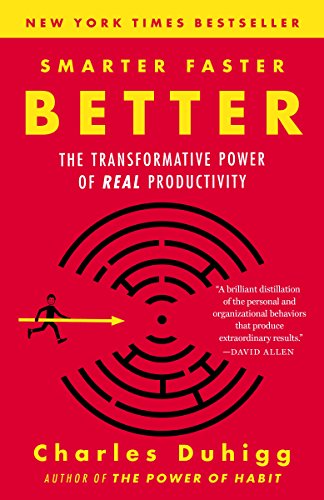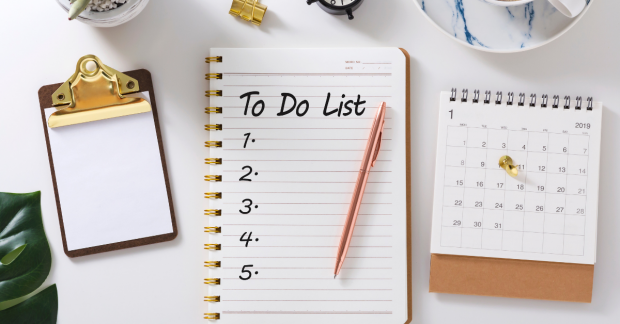Can your to-do list actually be holding you back?
One of the most common mistakes people make is thinking that as long as they have written down their tasks for the day, as long as they’re working and taking action, they’re productive, but that’s a massive misconception.
There’s a wild difference between being productive and being busy.

Smarter Faster Better
by Charles Duhigg
⏱ 14 minutes reading time
🎧 Audio version available
You Have Too Many Things on Your To-Do List
The poster child for productivity is often pictured as someone animatedly talking on the phone while typing an email, a cup of coffee on their desk, while the TV is blaring the latest news. This image is toxic, and it leads to one of the most common productivity mistakes: having too many things on your to-do list in the hopes that you’ll just multitask.
Contrary to popular belief, multitasking is the enemy of productivity, not the definition for it. Handling several tasks at once doesn’t mean that you’re brilliant at your job.
Studies have proven time and time that the human brain can only fully process one thing at a time. So when you’re doing two things at the same time, you’re just doing one of these tasks after another, not in parallel.
Adding too many things to your to-do list is counterproductive. A mile-long to-do list provokes feelings of discouragement and overwhelms the person looking at it.
Before you add dozens of tasks to complete each day, think about the amount of time each task will realistically take. And then think about the preparation needed and the order of the importance of the task in the first place.
When you’re staring at this cluttered schedule, completing every single item on your list on a consistent basis is exhausting.
The solution for this is to mark three crucially essential tasks for each day. These tasks are the ones that hold the most value, reap the biggest benefits, and so they should have top priority. Completing tasks by order of importance is also a great help when it comes to finishing your list.
Not Taking Rest Into Consideration
6:00 A.M: wake up. 7:00: get to work. 5:00, come home, eat dinner, catch up on late assignments, try to get ahead of tomorrow’s work, and repeat the next morning.
People think that they’re productive when they cram their schedule full with too many projects, but they rarely take into account the first thing needed to be productive in the first place: sleep– just because it doesn’t seem like a priority at the time.
By the time college and work roll around, people boast about who had less sleep the night before.
When you don’t sleep– when you don’t rest, you’re not at your best. Just because this way there is technically more time in your day, that doesn’t mean you’re using it to the fullest. The health benefits of sleep far outweigh those few extra hours you earned by going to sleep at an exhausting hour.
During the day, people need to schedule more breaks than they think as well. Nonstop work slows down productivity like no other. A break refreshes your mind, allows you to refuel with food, and jump back to work with more enthusiasm.
So the best way to get more rest and sleep is to treat it like any other item on your to-do list, schedule it in.
Your List Isn’t Realistic
A lot of people take to writing down tasks without having a defined beginning or endpoint. When you’re leaving things open like that, this brings results that aren’t very productive because you don’t know where or how to start. For example, your task reads, “Finish Paperwork” or “Do Presentation.”
You are being ambiguous to yourself because you don’t have an actionable task to follow and accomplish. Watch the phrasing of your to-do list. Instead of leaving things open-ended like that, phrase your tasks as, “Write the rough draft” or “Write Three Ideas for Presentation.”
Each task on your list should include a specific action. There should be a clear outcome of each task, a time period during which it can be done, and a defined endpoint.
The same goes for having pointless goals. When the task is marked down in front of you is related to a goal that holds personal value, you won’t need to dig for the willpower to get it done. This is so important that you actually can’t wait to work on it!
So before creating a to-do list and writing down goals, have a defined, clear reason why each item deserves this time of your day.
Harder Tasks are at the Bottom of the List
You may believe that by putting in the simpler, easier tasks first that you’re encouraging yourself to follow your to-do list, and that may work for a while, but putting the harder tasks at the bottom of your list is the same as putting them off.
This leads to procrastinating performing that task because you have already drained your willpower for the day.
Instead, place the hardest, most difficult tasks at the very top of your list. Once you finish it and have that heavy burden out of the way, then you’ll feel more on top of things and will be able to tackle that to-do list.
As they say, “Eat that Frog!” which means that the first thing you should do in the morning is to eat a live frog, then “you can go through the rest of the day knowing the worst is behind you. Your frog is your worst task, and you should do it first thing in the morning.” Adding to this is, “If you have to eat two frogs, eat the ugliest one first.”
The rest of the day will feel like a breeze.
Related: How to Get More Done in a Week Than Most People Do in a Month
There Are Too Many Systems
There is a to-do list pit that a lot of people fall into, and it’s using too many systems and tools to organize it, especially if a new time management or productivity system is involved or a tool or app.
With every change that comes along, there is a learning curve, and we lose precious time organizing and learning instead of using that time to do what we’re supposed to be doing.
Ask yourself how many “productivity” systems and tools do you use? Do you spend a lot of time on them? How much of your day is spent tracking your progress and productivity?
The solution for this is to find a few methods and techniques that work for you.
Creating the List in the Same Day
There is nothing that leads to counter-productivity other than a badly structured to-do list, and one of the most common mistakes is that a lot of people create their to-do list on the same day that you’re meant to accomplish these tasks.
What this accomplishes is the opposite of what you’re looking for. You’re starting your day with a stressful brainstorming session and haggardly running back and forth trying to remember appointments or meetings and panicking if they overlap.
Making that checklist the evening before is what experienced to-do list users call a pro-move. And if you don’t want your tasks to take up your time after work, then plan for the next day before leaving the office.
Not Counting In Random Events
You’ve done things perfectly. Your to-do list is ranked from most to a least important task, you can’t wait for your scheduled break, and you may have already eaten that metaphorical frog that marks the day’s most difficult task– but suddenly, a random, unexpected event occurs. Your entire system and list are thrown off balance.
To avoid committing this mistake, it’s important to consider that each day is different, and random hurdles are bound to get thrown in your way. So while it’s important to structure your to-list and thus, structure your day, it’s equally important to allow room for flexibility.
Every day, go over your calendar and to-do list, look at all the activities you have written out, then look at the next few days’ schedule to see what else is planned. Once this is done, carve out at least one hour of free time for unplanned activities.
Unplanned activities include unexpected phone calls, or for some reason, you had to leave work– there are a plethora of unexpected events that can happen. Even the Internet shutting off for a few minutes can make your tasks overlap.
By creating this safety net, this cushion, that allows room for errors and emergencies, you’re radically reducing stress and panicky levels.
Worst case scenario? This random event took up a bigger time slot than you originally thought it needed. Best case scenario? No emergency cut in, and nothing extra came up, and you get to use that extra time to get ahead of your schedule.
What Is Snapreads?

With the Snapreads app, you get the key insights from the best nonfiction books in minutes, not hours or days. Our experts transform these books into quick, memorable, easy-to-understand insights you can read when you have the time or listen to them on the go.


